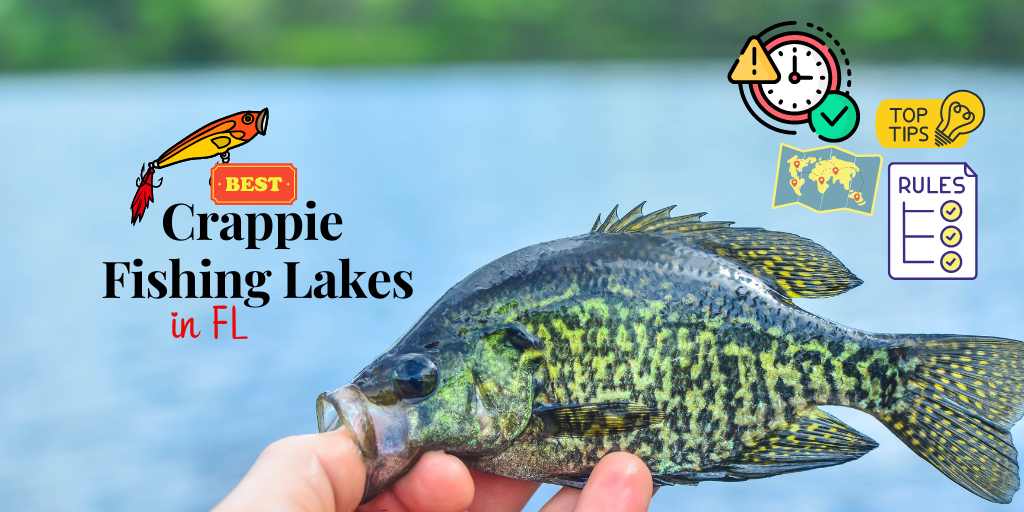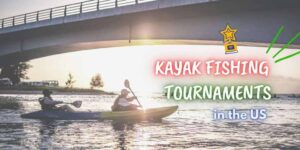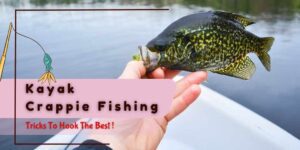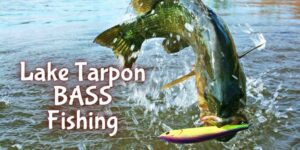Are you a passionate angler on the lookout for the best crappie fishing lakes in Florida? Look no further. With over 30,000 lakes, ponds, and reservoirs, Florida is a paradise for crappie fishing enthusiasts.
The Sunshine State boasts an abundance of clear, freshwater bodies of water that are home to some of the most giant crappies in the country.
But with so many options available, it can be overwhelming to choose the perfect spot for your next fishing trip. That’s why we’ve put together this guide to the best crappie fishing lakes in Florida, highlighting some of the top locations for catching these elusive fish.
So if you’re ready to cast your line and catch some crappie, read on to discover the best crappie fishing lakes in Florida and why they are worth a visit.

Jump To A Section
Types And Habits of Florida’s Crappie
Crappies are a popular target for anglers in Florida, and for a good reason. Known for their aggressive behavior, large size, and delicious taste, crappie offer a great challenge and reward for anglers.
Let’s take a look at their types first.
Types of Crappies Found in Florida
There are two species of crappie found in the state: black crappie (Pomoxis nigromaculatus) and white crappie (Pomoxis annularis). Though both species have similar physical characteristics, they have different habitat preferences and spawning habits, making them distinct species.
The black crappie is silver-green in color and has a black vertical band that runs along its sides. They also have a dark spot on the dorsal fin and six to eight spines on the anterior part of the dorsal fin.
White crappies, on the other hand, are silver in color and have seven to eight spines on the anterior part of their dorsal fin. They also have several dark spots along the side of their bodies.
Black crappie prefers to inhabit shallow, vegetated lakes and ponds. Furthermore, they are also known to be more aggressive feeders and tend to feed on insects, crustaceans, and smaller fish.
And when it comes to spawning, black crappie tends to spawn earlier in the spring than white crappie. Black crappie typically spawns when the water temperature reaches 58-65 degrees, while white crappie spawns when the water temperature reaches 65-75 degrees.
Feeding Habits of Florida’s Crappie
In terms of habitat preferences, both species of crappie prefer slow-moving water with plenty of vegetation, where they can hide from predators and find food.
White crappie tends to be found in more shallow water than black crappie and is often found in swamps and backwaters, while black crappie is more likely to be found in deeper, open-water areas.
Once within striking distance, they will quickly move in and capture their prey – a process that is often aided by their sensitive lateral line. This line runs along their sides and can detect even the slightest vibration in the water, giving them an edge when hunting for food.
The Top Five Best Crappie Fishing Lakes in Florida
Anglers everywhere have long known that Florida is one of the best places to go Crappie fishing, and with this guide, you’ll learn about the best places in the state for this type of fishing.
Here we’ve evaluated the best Crappie fishing lakes in Florida based on size, depth, water quality, and accessibility and have come up with a list of the top five best places for Crappie fishing.
Lake Okeechobee
Located in south-central Florida, Lake Okeechobee is the largest freshwater lake in the state, with a surface area of over 730 square miles. This lake is home to some of the most successful crappie anglers in the country, as the lake is full of brushy structures and plenty of deep channels.

The best time to catch crappie on Lake Okeechobee is during the winter months. This is typically from December to February. During this time crappies are more active and easier to catch here.
Look for areas with shallow water and vegetation, such as grass beds, reeds, and lily pads. These areas provide cover for crappie and attract baitfish, which in turn attract crappie. Also, try fishing around bridges, docks, and other structures where crappie can congregate.
Lake Istokpoga
Located in south-central Florida, Lake Istokpoga is a large lake with a surface area of over 30,000 acres. It’s known for its excellent crappie fishing, as the lake is full of aquatic vegetation and has numerous deep channels.
This lake is managed by the Florida Fish and Wildlife Conservation Commission. And they perform regular programs to ensure its biodiversity remains healthy. The commission also regularly stocks the lake with crappie to maintain the population.
The best times to fish for crappie on Lake Istokpoga are early in the morning or late in the afternoon when the water temperature is cooler.
Rodman Reservoir
Located in north-central Florida, Rodman Reservoir is one of the state’s premier crappie fishing lakes. This deep, clear body of water is surrounded by numerous productive brush piles and deep channels. It covers approximately 9,000 acres and is known for its abundant fish population, including crappie!
When fishing for crappie in Rodman Reservoir, keep in mind that the minimum size limit is 10 inches and the daily bag limit is 25 fish. You should also be aware that there are several species of bass, catfish, and panfish that inhabit the reservoir, so it’s important to be mindful of species regulations when fishing.
Lake Weir
Lake Weir, located in Marion County, Florida, is renowned for its crappie population. Offering anglers the chance to hook into these panfish year-round, it covers 700 acres.
With its picturesque scenery, abundant fish, and endless opportunities for outdoor adventure, Lake Weir is truly a gem of Florida’s freshwater fishing scene.
To make the most of your crappie fishing trip on Lake Weir, it’s important to have the right equipment and technique. It’s better to use light or ultra-light tackle with a 4-6 lb test line. Besides, using a slip bobber can help you suspend your bait at the right depth can increase your chances of catching crappie.
Orange Lake
Located in north Florida, Orange Lake is ideal for kayak fishing and is surrounded by lush vegetation and a variety of wildlife. The lake is teeming with aquatic life and the fish population is diverse and plentiful. Anglers from all over flock to the lake for the chance to land some of the biggest crappies around.
The lake also features ample access points for kayaks. This makes it easy for kayak fishers to get in on the action!
Crappie Fishing Tips For Florida
Crappie fishing in Florida can be an incredibly rewarding experience. But it can also be challenging to find the best spots and techniques for catching these hard-fighting fish. That’s why we’ve compiled a few tips in this guide.
Crappie Season In Florida
When it comes to crappie fishing in Florida, the best time to do it is largely dependent on the season. Crappies are a migratory species, and their behavior is affected by changing temperatures and weather patterns.
In Florida, the crappie season generally runs from late winter through mid-summer.
Let’s take a close look at different seasons for crappies;
In the late winter, as the water temperatures begin to warm up, crappie will start to move from deeper, cooler waters to shallow, warmer waters.
This is when the crappie becomes more active and begins to feed heavily, making it a great time to go crappie fishing. During this period, you can easily find crappies in shallow waters. Particularly, near shorelines, bridge pilings, and other structures.
In the spring, crappie moves into the shallower waters to spawn. This is an especially productive time to target crappie, as they are very active and will readily bite. Throughout springs, you’ll find crappies near cover and structures. Go for submerged logs, brush piles, and other man-made structures.
In the summer, crappie moves into deeper waters and become more lethargic. Throughout summer, they are easy to find in deeper waters, generally ranging from 10 to 30 feet. However, they will still bite when presented with the right bait! So summer can still be a productive time for crappie fishing in Florida.
When is the best time for catching Florida’s Crappie?
In Florida, the best time to catch crappie is during the early morning or late afternoon, when the water is cooler, and the fish are more active.
While less common, night fishing for crappie can be productive in Florida, particularly during the summer months. Use lights to attract baitfish and crappie and fish around submerged structures and cover.
So, plan your fishing trips around these times to increase your chances of catching crappie.
Learn to scout and identify Crappie fishing spots in Florida
Finding the right spots to fish for crappie is key to having a successful and enjoyable fishing experience, and there are a few tips and tricks that can help you maximize your chances of finding and catching crappie while fishing from a kayak in Florida.
First and foremost, it’s important to understand the difference between “targets” and “structure” when scouting for crappie fishing spots. Targets are areas where you’ll typically find crappies, such as weed beds, fallen trees, docks, and stumps.
Structure refers to areas of the lake or riverbed that have an unusually large concentration of crappie. These areas tend to have more cover, deeper water, and other factors that attract and hold crappie.
When scouting for crappie fishing spots, it’s a good idea to invest in a good quality fish finder. A fish finder can help you locate structures and targets in the water and make it easier to locate crappie. Look for areas of the lake or river that have an abundance of cover, and look for any deep holes or drop-offs near the cover. These areas are likely to be the best places to find crappie.
It’s also important to consider the time of day when you’re scouting for crappie fishing spots. During the early morning hours, look for areas that are near the shoreline, as crappie tend to move into shallow water to feed.
During the middle of the day, look for areas that are farther out in the lake or river where the sun is blocked by the trees on the shoreline. This is when the crappie will move deeper into the water to feed.
Lure and bait selection for Florida’s crappies
When selecting lures and baits for crappies, the key is to choose ones that will appeal to the fish’s feeding habits. Crappies like to hunt around covers such as sunken logs, brush piles, and rocks. The right lure or bait will make them come out of hiding to take a bite.
The most common type of bait used for crappies is live bait, such as worms, minnows, and crickets. Live bait is a great option for crappies because it’s easy to catch, and the fish are attracted to the movement of the bait. However, artificial lures can also be effective. Artificial lures can be used to simulate the movement of live bait, and they are often more successful than live bait in catching crappies.
And when selecting lures, look for lures that are specifically designed for crappies. These lures should be lightweight and have a natural look. Many lures are designed to look like minnows, worms, and other small creatures that crappies like to eat. Another option is to use bright colors and flashy materials to attract the attention of the fish.
The Best Way To Catch Florida’s Crappie
With the right technique and equipment, you can easily make the most out of your trip. However, there are some techniques and tips that can increase your chances of success:
Fish at the right time
Crappies are most active during low-light periods such as early morning or late afternoon. They also tend to be more active during the spawning season, which varies depending on location in Florida.
Use small jigs
Crappies are opportunistic feeders, so small jigs, crankbaits, and spinnerbaits will all work well. You can also use live bait, such as minnows, worms, and crickets, to attract the crappie. For the most success, you’ll want to target areas of the lake or river that have different depths and structures.
Fish in the right location
Look for areas with a structure, such as submerged trees, brush, or drop-offs where crappie are likely to hide. Use a fish finder or map to locate these areas.
Target weed beds: Weed beds are a favorite habitat of crappie, especially in Florida. Look for areas with submerged vegetation and fish around the edges of the weeds, where crappie are likely to be feeding.
Use live bait
Live bait, such as minnows or worms, is often the most effective way to catch crappie in Florida. Be sure to bring a variety of baits and experiment with different presentations to find what works best.
Fish shallow water
In Florida, crappie often moves into shallow water to feed, especially during the early morning and late afternoon. Try fishing in water less than 10 feet deep, particularly around areas with cover or structure.
Pay attention to the weather
Weather patterns can have a big impact on crappie fishing in Florida. On cloudy or overcast days, crappie may move into shallower water, while on sunny days, they may seek deeper, cooler water.
Stay patient
Crappies can be finicky and may require some persistence to catch. Don’t give up too soon, and be willing to try different techniques and locations.
Finally, we have included a few more tips for a successful fishing trip in Florida:
- Invest in the quality tackle and bait to increase your chances of catching crappie.
- Take the time to scout out the water and find the structure and cover that crappie prefer.
- When fishing, be sure to use a slow, steady retrieve to give the bait time to appeal to the crappie.
- If the fish are not biting, don’t be afraid to try different baits and lures.
Remember to follow all local fishing regulations and practice catch and release whenever possible to help conserve Florida’s crappie population.
Learn To Handle And Release Crappie To Minimize Harm
As an avid angler, you’re likely familiar with the thrill of catching big crappie. But when you catch one, it’s important to be aware of the proper handling and release techniques to minimize harm to the fish and the ecosystem. Here’s a quick overview of how to handle and release crappie the right way.
First, when you catch a crappie, it’s important to handle it carefully. It’s best to use wet hands or a soft, damp cloth to protect the fish from direct contact with human skin. Additionally, handle the crappie gently, and don’t squeeze it too tightly.
When it comes to releasing the crappie, it’s best to do it quickly and carefully. Be sure to get it back in the water as soon as possible and with as little contact with the air as possible. This is because the longer a fish is out of the water, the less likely it is to survive. If you plan on releasing the fish, don’t take it out of the water to take photos or admire it.
To ensure the crappie survives, it’s important to revive it before releasing it. When it’s removed from the hook, the crappie will likely be exhausted. To revive the fish, gently hold the fish in the water and move it back and forth to increase the oxygen circulation in its gills. This will help the crappie to regain its strength before being released.
Finally, when it’s time to release the crappie, do so far away from any obstacles, like rocks or logs. This will help to ensure the fish won’t be injured as it swims away.
Florida crappie limit
The crappie limit in Florida can vary depending on the location and the specific regulations set by the Florida Fish and Wildlife Conservation Commission (FWC). In general, the statewide limit for crappie (also known as speckled perch) in Florida is 25 per person per day, with a minimum size limit of 10 inches.
However, there are some exceptions to this limit depending on the specific lake or water body you are fishing in, so it’s important to check with the FWC or local authorities for any additional regulations or changes to the limit in your area.
It’s also important to practice catch and release whenever possible to help conserve Florida’s crappie population and ensure the sustainability of the fishery for future generations.
No matter where you’re fishing, it’s important to practice catch and release whenever possible to help conserve Florida’s crappie population and ensure the sustainability of the fishery for future generations.
While taking a few to share with friends and family is certainly enjoyable, allowing fish to return to their habitat can help maintain the integrity of a lake’s crappie population. Additionally, using barbless hooks and avoiding live bait when possible, can also help reduce the mortality rate of released fish.
Final Words
In conclusion, crappie fishing in Florida offers anglers a unique and exciting experience. With its mild climate and numerous lakes and rivers, the state provides an ideal habitat for this popular game fish.
To have a successful crappie fishing trip in Florida, it is essential to understand the behavior and habits of these fish. Anglers should focus on fishing in the early morning or late afternoon, using live bait or jigs to entice bites. Additionally, anglers should be aware of the state’s fishing regulations and obtain the necessary permits and licenses before setting out on the water.


